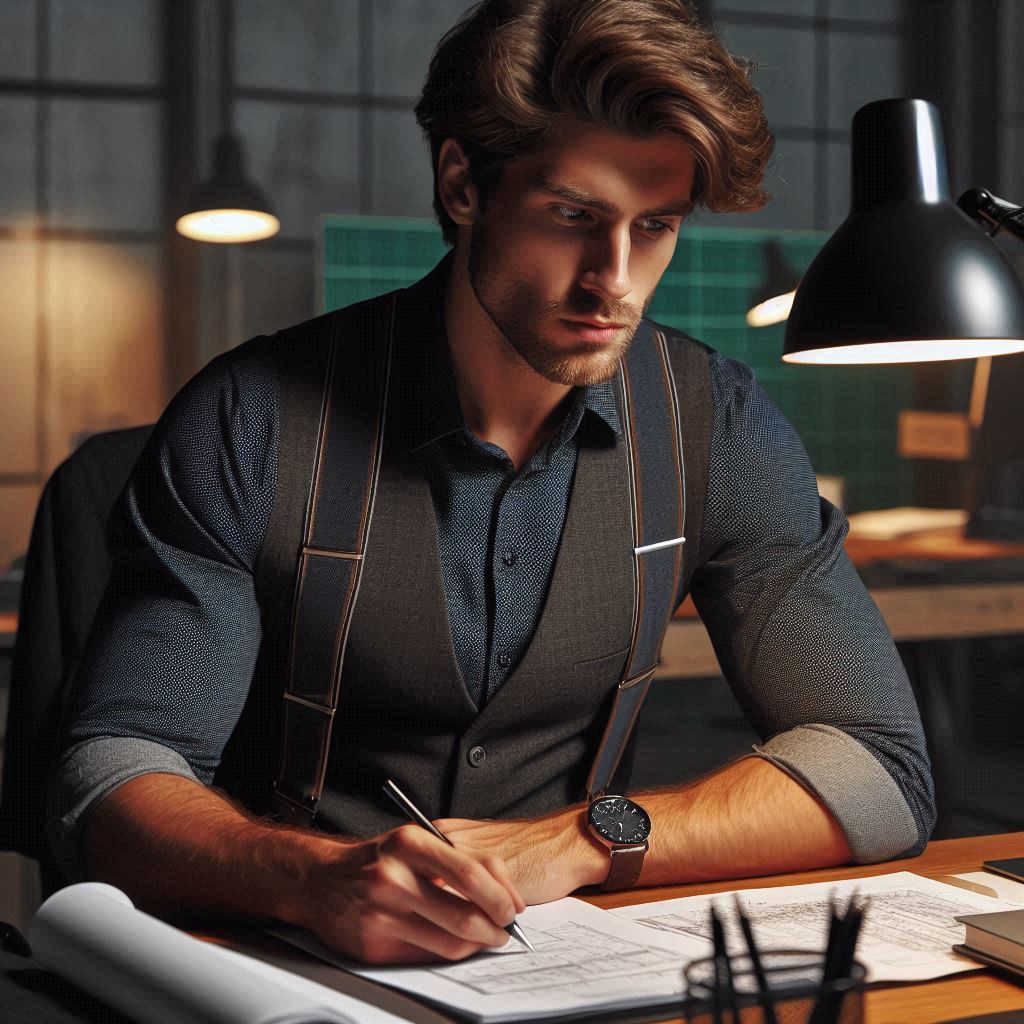Introduction
In the world of interior and exterior design, lighting design plays a crucial role in creating ambiance, enhancing aesthetics, and providing functionality.
Lighting design involves the deliberate use of light to achieve a practical or aesthetic effect.
Brief explanation of lighting design
Lighting design is the art of planning and implementing lighting in a space to meet the specific needs of the area.
It involves selecting the appropriate fixtures, determining the right placement, and creating the desired atmosphere through the use of light.
Importance of lighting design in various spaces
Lighting design is essential in various spaces such as homes, offices, restaurants, retail stores, theaters, and outdoor environments.
In residential settings, well-designed lighting can enhance the overall look and feel of a space, create focal points, and improve functionality.
In commercial spaces, lighting design can influence customer perception, highlight products, and contribute to the branding of a business.
Theatrical lighting is used to set the mood, create drama, and enhance performances.
Outdoor lighting design is critical for safety, security, and creating a welcoming ambiance.
Overall, proper lighting design can transform a space, improve the quality of life, increase productivity, and enhance the overall experience for occupants and visitors alike.
It is a vital aspect of interior and exterior design that should not be overlooked.
Understanding the Concept of Lighting Design
Definition of Lighting Design
Lighting design is the art and science of creating effective illumination for a space.
It involves planning and implementing lighting solutions that enhance functionality and aesthetics.
Designers consider how light interacts with surfaces and colors to create desired effects.
The goal is to balance visibility, comfort, and atmosphere within an environment.
Effective lighting design can transform a mundane space into a captivating experience.
Factors to Consider in Lighting Design
When designing a lighting scheme, several factors must be taken into account.
Functionality is a primary consideration.
Lighting should support the intended use of the space, whether it‘s for work, relaxation, or socializing.
Designers must assess how much light is needed to achieve specific tasks.
For example, a workspace requires brighter, more focused lighting than a cozy living room.
Aesthetics play a crucial role in lighting design.
The choice of fixtures, colors, and lighting effects must harmonize with the overall design concept.
Designers should consider the style and mood they want to convey.
This might include using warm tones for a welcoming atmosphere or cooler tones for a modern feel.
Effective lighting should enhance the architectural features and decor while creating a cohesive visual experience.
Energy efficiency is another critical factor in lighting design.
Designers increasingly prioritize sustainable solutions to reduce environmental impact.
This includes selecting energy-efficient fixtures and implementing smart lighting controls.
Efficient lighting reduces energy consumption and operational costs for the end user.
Using LED technology is one way to achieve energy efficiency.
LEDs consume less power and have a longer lifespan than traditional bulbs.
Importance of Collaboration Between Designer, Architect, and Electrician
Collaboration is essential for successful lighting design.
The designer must work closely with architects to align lighting with the overall design vision.
Architects provide insight into how lighting will interact with the space‘s structure and materials.
This ensures that the lighting complements the architectural elements and serves its intended purpose.
Electricians play a vital role in the execution of the lighting design.
They bring the designer‘s vision to life by installing fixtures and ensuring proper functionality.
Collaboration with electricians early in the process allows for efficient planning.
This helps avoid potential issues related to wiring, fixture placement, and energy supply.
Open communication among the designer, architect, and electrician fosters a cohesive approach to the project.
Generally, lighting design involves more than just choosing fixtures.
It encompasses understanding functionality, aesthetics, and energy efficiency.
Collaboration between designers, architects, and electricians is crucial for success.
By working together, these professionals can create spaces that are beautifully lit, functional, and sustainable.
Effective lighting design enhances the user experience and elevates the overall quality of the environment.
Read: Visual Merchandiser: Job Market and Opportunities
Initial stages of lighting design process
When it comes to creating a successful lighting design, the process begins with the initial stages that set the foundation for the entire project.
Researching and gathering information about the space
Before diving into the actual design phase, it’s crucial to gather as much information about the space as possible.
This includes understanding the layout, dimensions, existing lighting conditions, and any specific requirements or constraints that need to be considered.
By conducting thorough research and analysis, designers can gain valuable insights that will inform their design decisions.
This step is essential for ensuring that the final lighting design meets the needs and expectations of the space.
Creating a lighting design plan
Once the necessary information has been collected, the next step is to create a comprehensive lighting design plan.
This plan serves as a roadmap that outlines the overall concept, vision, and goals of the project.
During this stage, designers will determine the type and placement of lighting fixtures, as well as the desired lighting effects and ambiance.
By developing a clear plan, designers can effectively communicate their vision and ensure that all stakeholders are aligned on the design direction.
Selecting the right fixtures and lighting technology
With the design plan in place, the next step is to select the appropriate fixtures and lighting technology that will bring the design to life.
This involves choosing fixtures that not only complement the design aesthetic but also meet the functional requirements of the space.
Designers must consider factors such as the type of light output, color temperature, and energy efficiency when selecting fixtures.
Additionally, they need to stay updated on the latest lighting technologies to ensure that the design incorporates the most innovative solutions available.
Basically, the initial stages of the lighting design process are critical for laying the groundwork for a successful project.
By conducting thorough research, creating a detailed plan, and selecting the right fixtures and technology, designers can set the stage for a lighting design that enhances the functionality and aesthetics of any space.
Read: Top Skills Needed for Art Educators and Instructors
Design development and implementation
When it comes to lighting design, one of the crucial stages in the process is design development and implementation.
This phase involves taking the initial concept and turning it into a fully realized lighting plan that enhances the space while also meeting the functional needs of the area.
Developing a Lighting Layout Plan
One of the first steps in design development is creating a lighting layout plan.
This involves determining where light fixtures will be placed, the type of fixtures to be used, and the quantity needed to adequately light the space.
Factors such as the size and purpose of the room, as well as natural light sources, will influence the layout plan.
Transform Your Career Today
Unlock a personalized career strategy that drives real results. Get tailored advice and a roadmap designed just for you.
Start NowDeveloping a well-thought-out lighting layout plan is essential for ensuring that the space is properly illuminated and that the design scheme is cohesive and visually appealing.
Incorporating Lighting Controls and Dimmers
Another important aspect of design development is incorporating lighting controls and dimmers.
These components allow for greater flexibility and customization of the lighting scheme, as they enable users to adjust the intensity and color temperature of the lighting to suit different activities and moods.
By incorporating lighting controls and dimmers into the design, you can create dynamic lighting effects, highlight architectural features, and enhance the overall ambiance of the space.
Creating a Cohesive Lighting Design Scheme
One of the key goals of design development is to create a cohesive lighting design scheme that complements the overall aesthetic of the space.
This involves selecting light fixtures that not only provide adequate illumination but also enhance the architectural elements and interior decor.
By carefully choosing fixtures that are in harmony with the style and color scheme of the space, you can create a unified look that ties the room together and creates a visually pleasing environment.
Therefore, design development and implementation are essential stages in the lighting design process.
By developing a lighting layout plan, incorporating lighting controls and dimmers, and creating a cohesive design scheme, you can achieve a well-lit space that is both functional and visually appealing.
Read: Breaking Down Iconic Movie Costumes

Execution of lighting design plan
Installation of Lighting Fixtures
When installing lighting fixtures, start by reviewing the design plan.
Ensure all fixtures align with the approved design specifications.
Carefully follow the manufacturer‘s guidelines for each fixture.
Proper installation not only ensures performance but also maximizes safety.
Use the appropriate tools and equipment to avoid damage or accidents during the installation process.
Electrical work should always be handled by licensed professionals.
They ensure that all wiring meets industry standards and local codes.
This professional touch minimizes the risk of electrical failures or hazards.
Moreover, a well-executed installation helps maintain the integrity of the overall design.
After installing the fixtures, the next step involves testing and adjusting lighting levels.
This process ensures that the lighting achieves the desired ambiance and functionality.
Begin by turning on all fixtures and observing their performance.
Look for any areas that may be overly bright or dim.
Testing and Adjusting Lighting Levels
Adjusting lighting levels involves more than just switching lights on and off.
Use dimmers and controls to fine-tune the brightness.
This adjustment allows for flexibility in different settings and times of day.
Pay attention to how the light interacts with the surrounding space.
Notice how it affects colors, textures, and overall visibility.
In addition to brightness, consider the distribution of light.
Ensure that light is evenly spread across surfaces, avoiding harsh shadows or glare.
Use a light meter to measure levels accurately.
This tool helps confirm that each area receives the correct amount of light.
Once testing is complete, document the final settings for future reference.
This documentation will assist in maintaining the lighting over time.
Ensuring Compliance with Safety Regulations
Compliance with safety regulations is a critical aspect of lighting design execution.
Familiarize yourself with local building codes and regulations regarding lighting installations.
These codes often specify requirements for energy efficiency, safety, and accessibility.
Ensure that all fixtures are installed according to these guidelines.
This compliance minimizes risks and promotes the safety of occupants.
Additionally, consider any requirements for emergency lighting and exit signs.
These elements are vital for ensuring safe evacuation in emergencies.
Regular inspections and maintenance should follow the installation.
Schedule routine checks to verify that all fixtures operate correctly and safely.
In short, the journey from lighting design concept to execution involves careful installation, thorough testing, and strict adherence to safety regulations.
By following these steps, designers can ensure that their lighting systems are effective, safe, and aesthetically pleasing.
Proper execution brings the lighting vision to life, enhancing the overall experience within a space.
Read: Visual Merchandiser: Job Market and Opportunities
Discover More: The Importance of Networking in the Art and Design World
Fine-tuning and Adjustments
Fine-Tuning the Lighting Design to Suit the Space’s Needs
Fine-tuning lighting design begins with understanding the space‘s purpose.
Different environments require different lighting approaches.
For example, an art gallery needs ambient lighting to highlight artwork without causing damage.
In contrast, an office may require bright, focused lighting to enhance productivity.
Designers must consider the layout and architecture of the space.
They should assess natural light sources and how they interact with artificial lighting.
This evaluation helps determine the best placement for fixtures and bulbs.
Task lighting, ambient lighting, and accent lighting should work together to create a cohesive atmosphere.
Designers can achieve this by layering different types of lighting to enhance the space’s functionality and mood.
Making Necessary Adjustments Based on Feedback
After the initial lighting design is implemented, gathering feedback is essential.
Engaging with occupants helps identify any issues with the lighting scheme.
Users may express concerns about brightness levels, glare, or uneven light distribution.
By listening to feedback, designers can pinpoint areas for improvement and make necessary adjustments.
Adjustments may include changing the type of bulbs, altering fixture placement, or modifying dimming controls.
For example, if a workspace feels too harsh, designers can switch to warmer bulbs or add dimmers.
Making these changes enhances comfort and usability, ensuring the lighting meets the needs of those who inhabit the space.
Additionally, designers should conduct follow-up assessments to monitor the effectiveness of adjustments.
This iterative process allows for continuous improvement and adaptation, ensuring that the lighting design remains relevant and functional.
Ensuring Optimal Functionality and Aesthetics
Achieving the perfect balance between functionality and aesthetics is crucial in lighting design.
Designers must ensure that lighting effectively serves its purpose while enhancing the overall visual appeal of the space.
They can achieve this by considering factors like color temperature, fixture design, and light distribution.
Color temperature influences how a space feels.
Warmer tones create a cozy atmosphere, while cooler tones promote focus and alertness.
Designers should carefully select the right temperature based on the space‘s purpose and ambiance.
Aesthetically pleasing fixtures also contribute to a successful lighting design.
Unique or decorative light fixtures can serve as focal points in a room.
Designers should choose fixtures that complement the overall design theme while fulfilling practical needs.
In summary, fine-tuning lighting design is essential for meeting a space’s unique needs.
Gathering feedback and making necessary adjustments ensures optimal functionality and aesthetics.
By focusing on these aspects, designers can create well-lit spaces that enhance both user experience and visual appeal.
Collaboration with other professionals
Working closely with architects and interior designer
Collaboration between lighting designers and architects is essential to create a cohesive and functional space.
Both professions bring unique perspectives to the table, and when they work together, they can ensure that the lighting design enhances the overall vision of the project.
Architects are responsible for the overall structure and layout of a space, so it’s crucial for lighting designers to understand the architectural plans and specifications.
By working closely with architects, lighting designers can ensure that the lighting fixtures are placed in optimal locations to highlight architectural features and create a harmonious atmosphere.
Interior designers are also important collaborators in the lighting design process.
They focus on the aesthetics and functionality of the interior space, so their input is valuable in selecting the right lighting fixtures and designing lighting schemes that complement the overall design scheme.
By collaborating with interior designers, lighting designers can create a cohesive look that resonates with the client’s vision.
Communicating effectively with electricians and contractors
Effective communication with electricians and contractors is essential to ensure that the lighting design is implemented correctly and within budget.
Lighting designers need to work closely with electricians to understand the technical requirements of the lighting fixtures and to ensure that the installation process runs smoothly.
Electricians play a crucial role in bringing the lighting design to life, so it’s important for lighting designers to communicate their vision clearly and provide detailed instructions.
By collaborating with electricians, lighting designers can address any technical challenges that may arise during the installation process and make adjustments as needed.
Contractors are also key partners in the execution of a lighting design project.
They are responsible for managing the construction process and coordinating the work of various trades.
Lighting designers need to work closely with contractors to ensure that the lighting design is integrated seamlessly into the overall project timeline and that all parties are aligned on the project goals and objectives.
Ensuring a seamless integration of lighting design with overall project
One of the key responsibilities of a lighting designer is to ensure that the lighting design seamlessly integrates with the overall project vision.
This involves considering the architectural and interior design elements of the space and designing lighting schemes that enhance the overall aesthetic.
Lighting designers need to be mindful of the project’s scope, budget, and timeline to ensure that the lighting design aligns with the client’s expectations and project requirements.
By collaborating with architects, interior designers, electricians, and contractors, lighting designers can create a cohesive lighting design that enhances the functionality and visual appeal of the space.
Transform Your Career Today
Unlock a personalized career strategy that drives real results. Get tailored advice and a roadmap designed just for you.
Start NowEssentially, collaboration with other professionals is essential for the successful execution of a lighting design project.
By working closely with architects, interior designers, electricians, and contractors.
Lighting designers can create cohesive and functional lighting schemes that enhance the overall project vision and create a memorable experience for the end user.
Conclusion
The importance of lighting design cannot be overstated in creating functional and visually appealing spaces.
Lighting plays a crucial role in setting the mood, highlighting architectural features, and enhancing the overall aesthetics of a space.
Collaboration is key in the lighting design process, as it involves working closely with architects, interior designers, and electrical engineers to ensure that the lighting scheme aligns with the overall design concept.
Attention to detail is essential in achieving a cohesive and harmonious lighting design that meets the specific needs and requirements of the space.
By paying attention to the intricate details of lighting design, such as fixture selection, placement, and control systems.
Designers can create dynamic and engaging environments that not only meet the functional needs of the users but also enhance the overall experience of the space.
Ultimately, lighting design is a creative and technical process that requires a deep understanding of light, space, and human perception.
By approaching lighting design with a collaborative mindset and meticulous attention to detail, designers can transform ordinary spaces into extraordinary visual experiences that leave a lasting impact on those who inhabit them.




